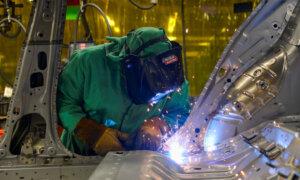‘We have had a significant increase in materials cost for our manufacturing side,’ an industry small-business owner said in a survey.
Factory activity in New York state plummeted to its lowest level in nearly two years as business conditions deteriorated and cost pressures accelerated, the Federal Reserve Bank of New York reported.
The Federal Reserve Bank of New York’s Empire State Manufacturing Index—a monthly survey to determine the sector’s prevailing economic direction—plunged by 26 points to negative 20 in March, the lowest since May 2023.
This was well below the market estimate of negative 0.75.
Last month, business conditions deteriorated as new orders and shipments fell sharply. Inventories continued to expand, while delivery and supply availability were little changed.
Cost pressures increased for the third consecutive month. Input prices and selling inflation climbed to their highest levels in about two years.
Surveyed manufacturing executives reported modest declines in employment and hours worked.
Companies’ optimism deteriorated for the second straight month. Expectations for business activity slumped, and input price pressures are anticipated to remain elevated. Capital spending plans remained soft.
Higher prices have been seen in widely watched reports, including the February S&P Global U.S. Manufacturing Purchasing Managers’ Index.
U.S. manufacturing sector growth accelerated last month as output and new orders surged at a solid pace. However, cost and output prices jumped to high levels.
“Worries have noticeably swelled in relation to the inflationary impact of tariffs, which were widely reported as having caused factory input costs to spike higher in February,” Chris Williamson, chief business economist at S&P Global Market Intelligence, said in the report.
“These higher costs are being passed on to customers, resulting in the strongest factory gate price inflation recorded for two years, which manufacturers fear may in turn not only damage sales in the coming months.”
From 2022 to 2024, the manufacturing sector experienced elevated price pressures, ranging from 3.7 percent to 5.3 percent. New York Fed economists wrote that manufacturing companies do not anticipate that inflationary challenges will dissipate in the year ahead.
“On average, service firms expect costs to rise at a 5.7 percent pace, while manufacturing firms expect cost increases to rise 2.5 percentage points to 7.3 percent,” they said in a March 5 paper.
Other regional central banks will be releasing their industry surveys in the coming days.
The next one will be the Philadelphia Fed Manufacturing Survey, scheduled for release on March 20. Early estimates suggest it will register weakness.
Tariff Nudge
President Donald Trump has given U.S. companies a choice: Continue foreign manufacturing and endure a climate of hefty tariffs or return to the United States and pay lower taxes.

Treasury Secretary nominee Scott Bessent testifies before the Senate Committee on Finance on Capitol Hill in Washington on Jan. 16, 2025. Madalina Vasiliu/The Epoch Times
Treasury Secretary Scott Bessent, appearing at the Economic Club of New York, stated that the American Dream is not contingent on accessing cheap goods produced overseas.
“The American Dream is rooted in the concept that any citizen can achieve prosperity, upward mobility, and economic security,” Bessent said in a speech earlier this month. “For too long, the designers of multilateral trade deals have lost sight of this. International economic relations that do not work for the American people must be reexamined.”
In the summer of 2024, Vice President JD Vance, a U.S. senator at the time, stated that losing one American manufacturing job is not worth “a million cheap, knockoff toasters.”
But while this sentiment is meant to bolster domestic manufacturing, the business community has flashed mixed signals.
The Business Roundtable recently released its first-quarter 2025 CEO Economic Outlook Survey. This is a composite index of CEO expectations for capital spending, employment, and business activity over the next six months.
The overall survey dipped from the fourth quarter, reflecting a moderation in executives’ plans and projections.
“The survey results signal that our members are cautious about the next six months, but also see opportunities to improve growth,” Chuck Robbins, head of the Business Roundtable and CEO of Cisco, said in a statement.
“America’s leading CEOs know how critical it is to work with Washington to swiftly enact pro-growth policies that will drive domestic investment, innovation and job creation, and we are committed to these efforts.”
The survey identified several policies that could be implemented to boost U.S. manufacturing. A majority of respondents listed maintaining a competitive tax rate and keeping tariffs low on inputs and materials that cannot be sourced in the United States. In addition, 55 percent cited streamlining the permitting process and investing in advanced infrastructure.
Small businesses in the manufacturing sector have also shared their consternation surrounding adjustments to trade policy.
The latest RedBalloon-PublicSquare Freedom Economy Index indicated a post-election turnaround in economic expectations and confidence, with many anticipating robust growth over the next 12 months.
Still, a small-business owner in the manufacturing sphere reported facing higher input costs.
“We have had a significant increase in materials cost for our manufacturing side. That has had a significant direct negative impact on our ability to grow and hire employees,” the survey respondent stated.
Trump recently instituted 25 percent tariffs on all aluminum and steel imports and is poised to introduce reciprocal tariffs on all U.S. trading partners next month.







